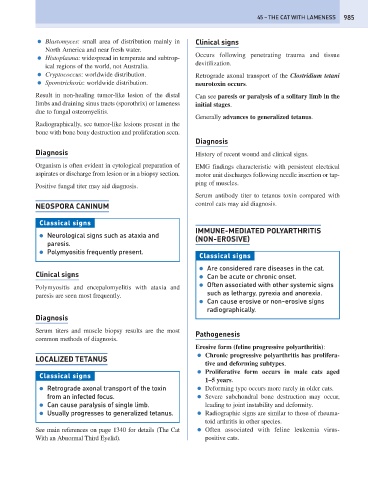Page 993 - Problem-Based Feline Medicine
P. 993
45 – THE CAT WITH LAMENESS 985
● Blastomyces: small area of distribution mainly in Clinical signs
North America and near fresh water.
Occurs following penetrating trauma and tissue
● Histoplasma: widespread in temperate and subtrop-
devitilization.
ical regions of the world, not Australia.
● Cryptococcus: worldwide distribution. Retrograde axonal transport of the Clostridium tetani
● Sporotrichosis: worldwide distribution. neurotoxin occurs.
Result in non-healing tumor-like lesion of the distal Can see paresis or paralysis of a solitary limb in the
limbs and draining sinus tracts (sporothrix) or lameness initial stages.
due to fungal osteomyelitis.
Generally advances to generalized tetanus.
Radiographically, see tumor-like lesions present in the
bone with bone bony destruction and proliferation seen.
Diagnosis
Diagnosis History of recent wound and clinical signs.
Organism is often evident in cytological preparation of EMG findings characteristic with persistent electrical
aspirates or discharge from lesion or in a biopsy section. motor unit discharges following needle insertion or tap-
ping of muscles.
Positive fungal titer may aid diagnosis.
Serum antibody titer to tetanus toxin compared with
NEOSPORA CANINUM control cats may aid diagnosis.
Classical signs
IMMUNE-MEDIATED POLYARTHRITIS
● Neurological signs such as ataxia and (NON-EROSIVE)
paresis.
● Polymyositis frequently present.
Classical signs
● Are considered rare diseases in the cat.
Clinical signs ● Can be acute or chronic onset.
● Often associated with other systemic signs
Polymyositis and encepalomyelitis with ataxia and
such as lethargy, pyrexia and anorexia.
paresis are seen most frequently.
● Can cause erosive or non-erosive signs
radiographically.
Diagnosis
Serum titers and muscle biopsy results are the most
Pathogenesis
common methods of diagnosis.
Erosive form (feline progressive polyarthritis):
● Chronic progressive polyarthritis has prolifera-
LOCALIZED TETANUS
tive and deforming subtypes.
● Proliferative form occurs in male cats aged
Classical signs
1–5 years.
● Retrograde axonal transport of the toxin ● Deforming type occurs more rarely in older cats.
from an infected focus. ● Severe subchondral bone destruction may occur,
● Can cause paralysis of single limb. leading to joint instability and deformity.
● Usually progresses to generalized tetanus. ● Radiographic signs are similar to those of rheuma-
toid arthritis in other species.
See main references on page 1340 for details (The Cat ● Often associated with feline leukemia virus-
With an Abnormal Third Eyelid). positive cats.

